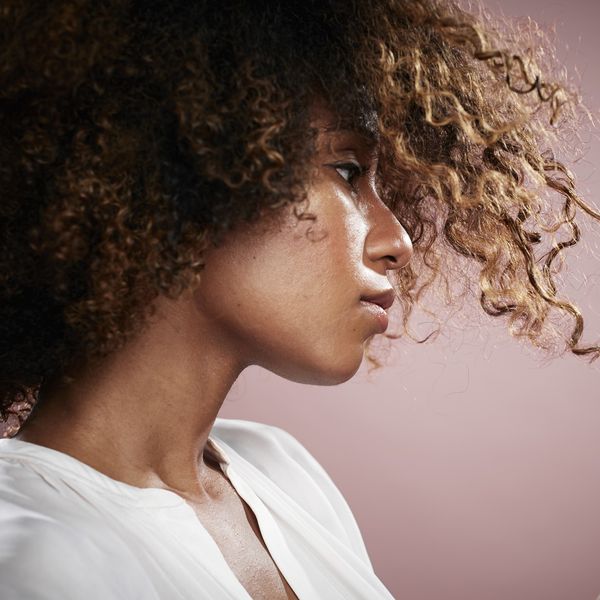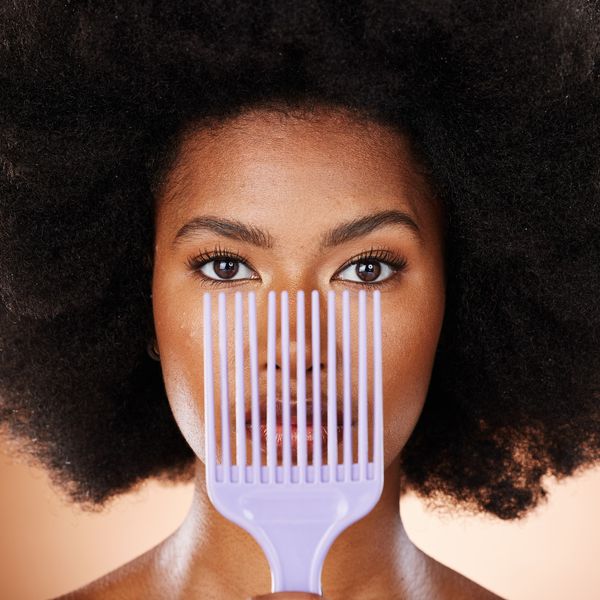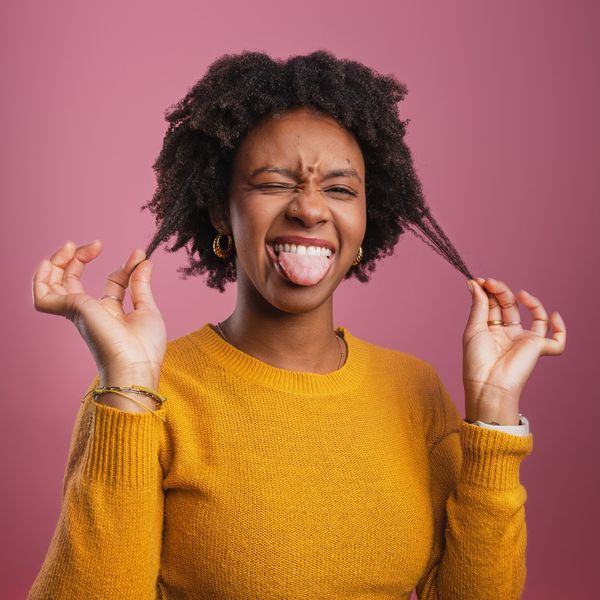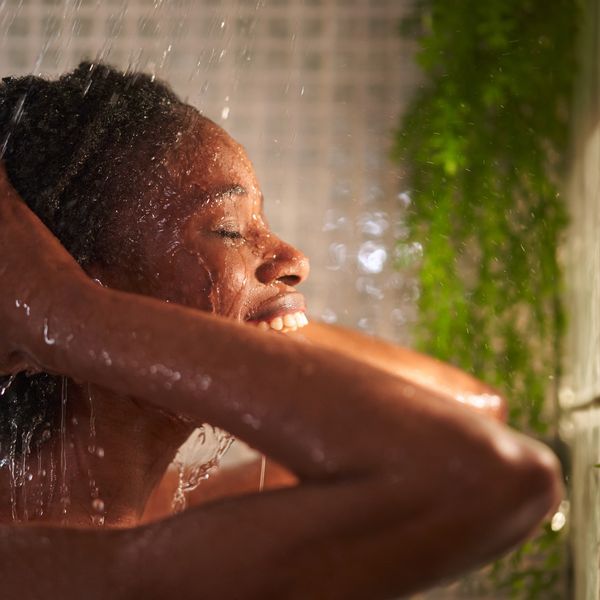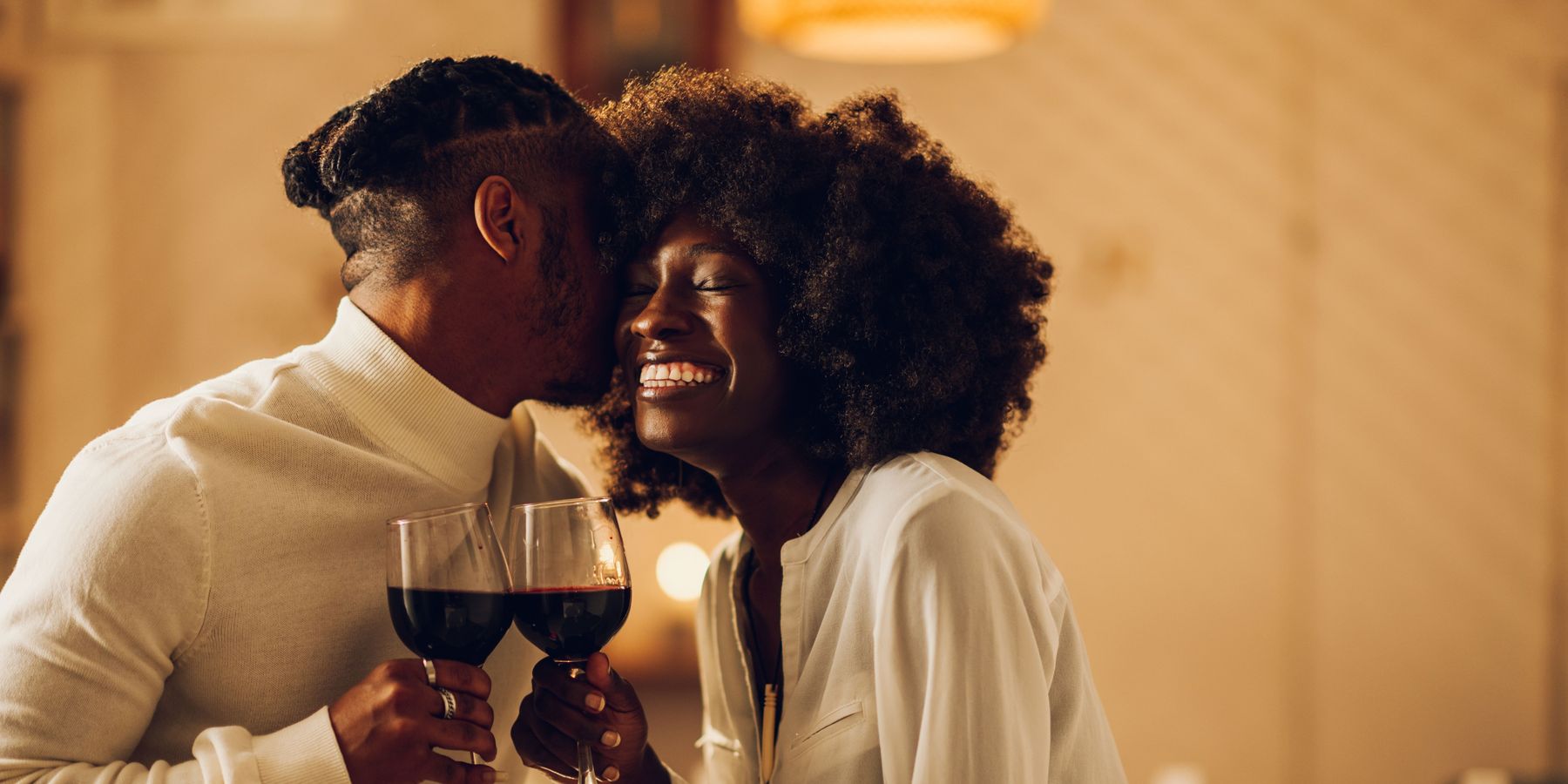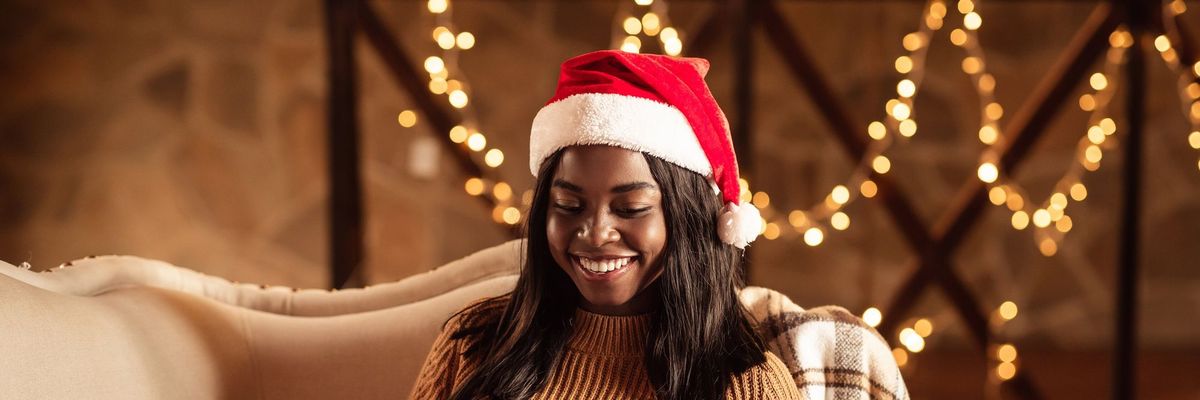
Jessica Zziwa. Indigenous Strandz. StayUniquee. Merry Curly. Maryam Hampton. BeYoutifully Natural. Seun Okimi. Believe you me, I could go on and on but for the sake of time and space, those are seven naturalistas on YouTube who have some pretty long hair (most of 'em are Type 4 hair too). I thought that shouting them out would be a great way to intro this because, if one of your New Year's desires is to have the longest ponytail ever come Christmastime, those women can inspire you—right along with some tips that I've got down below.
I won't lie to y'all. Genetics play a valid role in how long our hair gets and how fast it gets there. Yet if you're someone who thinks that you can't get longer tresses than you've ever had because your hair simply doesn't grow, that's a bold-faced lie. It grows. Somewhere around one-half inch and an inch a month, to be exact. You've just got to make sure that you do all that you can to retain your inches. That's where these tips come in.
How To Grow An Inch Of Hair Each Month
If your deepest desire is to keep as much new growth as possible, apply the following 10 suggestions and watch how close to your goal you get by around this time next year.
1. Take the “Less Is More” Approach
When I first began my own length retention journey, I would literally spend hours a week on YouTube, listening to what different naturalistas would put in their own hair to get the inches that they had. One tip that had me super stoked, I wrote about on here ("Looking For Hair Growth? It Might Be Time To Bring 'Blue Magic' Back"). I got so excited that I purchased 4-5 tubs of Blue Magic, right out the gate. Unfortunately, using it more than to seal my ends every once in a while ended up being way too heavy for my hair (although some folks have been thriving with it). Anyway, after spending more money than I ever thought I would on a bunch of other products that are still in both of my bathroom cabinets, the thought crossed my mind to simplify and see if that would be my best bet. It was. Hands down.
I'm not even going to get into the specific products that worked for me vs. the ones that didn't because it doesn't really matter. All of us are unique, so it really is different strokes for different folks. What I will say is clogging up your hair follicles and weighing down your strands with tons of stuff is gonna probably do more harm than good. So, get to know your hair type and texture, try a few things that are branded for those two things specifically and wait at least a month to see how it all turns out. In the long run, you'll probably come to realize what I did—that less (product) really is more when it comes to hair growth.
2. Boost Your Collagen Intake
If you want your hair to thrive, it definitely needs protein. Something that a lot of people don't realize is collagen is one of the most abundant forms of protein that there is. The reason why it's so good for your tresses is because, for one thing, your hair is made up of mostly protein (keratin). Also, collagen provides your hair with the amino acids that are necessary to build protein. Also, collagen fights off free radicals at the root (your hair follicles) and, as bonuses, it can slow down hair thinning and greying as well.This is why it's wise to eat foods that contain a good amount of collagen in them. Some of those include fish, chicken, berries, citrus fruits, red bell peppers, tomatoes and bone broth. If you'd like, you can also take a collagen supplement. A list of some of the best ones for 2021 can be found here.
3. Stay Hydrated
Our bodies are made up of more than 60 percent water, so of course, we need to consume a lot of it on a daily basis. Unfortunately, 75 percent of Americans are chronically dehydrated which can lead to all sorts of health issues. If you're wondering if you could be among that number, check out "10 Overlooked Signs That You're Dehydrated". As far as your hair goes, a sign that it could use some extra hydration from the inside out is if your strands feel dry and brittle, no matter what you do or if your scalp dry.
In the quest to have long hair, a lot of people overlook very simple steps. When it comes to making sure that your hair is moisturized, it's not going to matter how many moisture-rich products you use if your system is begging for water on the inside. So, definitely make sure that you get no less than eight glasses a day. Your hair will thank you with every sip.
4. Take a Vitamin B12 Supplement
A vitamin deficiency that is actually pretty prevalent within the Black community is Vitamin B12. What are some signs that you could be low in it? You're irritable. You have low energy. Your vision is blurry. You have an unexplainable shortness of breath. You're constipated. You sense that your muscles are weak. Your tongue feels "slicker" than usual. There's a random numbing or tingling feeling throughout your body. You've got memory loss. Your hair follicles are dormant.
Since Vitamin B12 is something that helps to keep your iron in good condition, when you don't have enough of it in your system, it can weaken the blood supply to your hair follicles which can result in weak follicles, hair thinning and even hair loss. This is why it's also a good idea to take a Vitamin B12 supplement and to eat foods that are loaded with this particular nutrient. Some of those include fortified cereals, salmon, eggs, Greek yogurt, and beef.
5. Wash Your Scalp More than Your Hair
A huge mistake that folks make when it comes to wash day is focusing a ton on their actual hair more than their scalp. The reason why this is a no-no is because your scalp is the foundation of your hair. If you don't get all of the gunk and build-up off of it, ultimately, your hair isn't going to thrive. Not only that but I once read an article that said, that a part of the reason why it seems that white women have more success with length retention is they shampoo their hair more often which means their scalp gets massaged more in the process.
First up—white women's hair doesn't grow faster. Their hair is straighter (so it appears that way), it's naturally oily (which makes it harder to break) and we experience more shrinkage (by a country mile). Second, I didn't just say all of that so that you would up your wash day frequency (more than once a week can rob your hair of the little natural oil that it has).
However, it is a good idea to detox your scalp once every 4 to 6 weeks, and massage your scalp at least once a week (all you need is to warm up a carrier oil like jojoba or avocado, put a few drops of lavender in it and then use your fingertips to rub your scalp for 5-10 minutes), and to definitely put more emphasis on washing your scalp than your hair. The key is to get your scalp really clean so that your follicles are healthy; your hair doesn't need that "squeaky feeling", tho. The cleanser that drips down from your scalp is more than enough.
6. Rinse Hair in Cool Water
It definitely feels divine to let hot water run down your hair and scalp, but it's actually not the best thing for your hair's progress. It's because hot (or even super warm) water can end up drying out your hair and causing frizz. So, how can you avoid all of this? By actually rinsing your hair in cool water after your deep condition it (because you do that every wash day so that it's extra moisturized, right?). Cool water is what will help to seal your hair's cuticles while closing the pores on your scalp too.
7. Dust More than Trim
Is there anything more annoying than uneven hair growth? When you want to get your hair down your back, probably not. The thing is, having one side of your hair that is thicker and grows faster is pretty normal, for two reasons. One reason is that the left vs. the right side of our bodies is not identical. This is why one of your feet or breasts may be bigger than the other. The other reason is that we tend to give one side of our hair more stress than the other when it comes to things like constantly sleeping on one side, parting our hair on one side—stuff like that.
While you would think that the remedy may be to constantly cut the "thriving side" so that it will catch up with the "weaker" one, that is actually gonna be more counterproductive than not. Your best bet would be to focus on dusting (lightly trimming) your ends (you can watch videos on how to do that here, here, and here) and then keeping your hair in a protective style so that you don't even have to think about it. Then, once the weaker side has made some real progress, you can get a trim to even things out. Make sense?
8. Remember That Protein Is Essential
Again, your hair is made up of protein, so it needs a lot of it in order to remain healthy and strong. Aside from what I already shared about getting more collagen into your system, something else that you should do is eat other foods that are high in protein. Meat is an automatic protein booster. If meat's not your thing, check out "Vegetarian Or Vegan? Check Out These High Protein Foods." for a list of other options.
Speaking of protein, it's also really important that you give yourself a protein treatment, about every six weeks. It's what will help to improve your hair's elasticity, so that it can endure more of the styling and manipulation that you do. A lot of people notice more breakage than they should because they miss this small-yet-impactful step. I hit on this specifically in "10 Things Your Natural Hair Needs In The Winter".
9. Leave Permanent Dye Alone
There used to be a time when you couldn't guess what color my hair was going to be on a pretty much weekly basis. Now that I know how detrimental hair dye and chemical relaxers are, especially to our health ("our" meaning Black women), I tend to use hair wax or a semi-permanent alternative (henna is a pretty good one too). Besides, if you are serious about gaining ½-1" of growth each month, permanent hair color is gonna be your ultimate nemesis. The main reason why is because the ammonia in hair dye strips your tresses of its natural pigment (in order to deposit the color) which can make your hair brittle as all get out. And if your hair keeps breaking off, you'll never reach your hair goals.
I know for some of you, it sucks to even think about going without dye. But sometimes we've gotta make sacrifices for the greater goal. Bottom line, color or inches? In 2021, which one is it gonna be?
10. Use Saw Palmetto Oil
If there's a new oil that you'd like to try on your hair, my vote is saw palmetto. It has a great reputation for preventing and even restoring hair loss because it blocks an androgen known as DHT from developing in our bodies. Why does that matter? Because DHT plays a direct role in hair loss. Saw palmetto also has a pretty good reputation for increasing hair density too. Not only that but it's an oil that can decrease inflammation, treat urinary tract infections and can regulate your man's testosterone levels too. For internal health benefits, it's probably best to consume it as a supplement (like maybe a liquid extract) or in tea form. If you want it to be the main oil that you use for those scalp massages that we already talked about, a cool place to purchase some is right here.
11. Apply Extreme TLC to Your Ends
One more time for those in the back. Again, a myth that you need to make sure to debunk for the rest of your life is your hair doesn't grow. That is a damn lie. If you are living, your hair is growing. The reason why a lot of us don't see proof of this is because our ends break off as fast as our roots grow. The way to prevent this from (further) happening to you is to treat the ends of your hair like you would a newborn baby in the sense that you choose to treat them oh so very gently. Seal them on wash day. Try and keep your hair in a protective style (even if that's a wig) most days of the week. Wrap your hair up in a silk or satin scarf (or bonnet) at night (friction is your hair's enemy too). Let straggly ends go. When your hair is out, keep your hands out of it. Simple things like this will keep your ends about as fresh as your roots.
12. Stick with What Works
Out of all of what I said, the main thing to remember when it comes to achieving hair growth is you've absolutely got to be as patient with the process as possible. The reality is, growing out your hair is a lot like baking some cookies—if you keep watching the oven or your roots, it's going to seem like nothing is happening. However, if you cultivate a routine, stick with it and try and leave your hair alone as much as possible, by June you could have 4-6 inches and by December…at least double that!
Alright. Let me get off of here and nurture these cornrows I've got so that I can walk the talk, chile. Let's all check back in around the holidays to see how things have been going. Can't wait to see you flipping your hair back. Whew, girl. #wink
Featured image by Shutterstock
- Why Won't My Natural Hair Grow? - xoNecole: Women's Interest ... ›
- “Denial Length”? Here's Why You Should Trim Your Hair ›
- This Is Why Your Natural Hair Ain't Growin' - xoNecole: Women's ... ›
- Does Blue Magic Hair Grease Make Your Hair Grow? - xoNecole ... ›
- Rice Water For Hair Growth - xoNecole ›
This Is How To Keep 'Holiday Season Stress' From Infecting Your Relationship
Hmph. Maybe it’s just me, but it seems like there is something really weird happening in the fall season air (because winter doesn’t officially begin until December 21) that cuddle season is in full swing while break-up season is as well. In fact, did you know that break-ups are so popular during the holiday season that December 11 is deemed Break-Up Day?
The reasons why relationships shift around this time vary; however, I did both roll my eyes and chuckle when I read that a very popular one is because it’s an easy way to get out of getting one’s significant other a Christmas present. SMDH.
Anyway, I personally think that the less shallow folks out here may contemplate calling things “quits” or they at least distance themselves a bit from their partner (and what I’m referring to is serious relationships) due to all of the stress and strain that oftentimes comes with the holidays whether it be financial, familial, due to their tight schedules or something else.
Listen, I would hate for you and your man to miss the fun and happiness of experiencing this time of year, all because you are so overwhelmed or irritated that you can’t really enjoy it. That’s why I have a few practical tips for how to avoid allowing the typical holiday season stress from INFECTING your relationship.
Manage Your Expectations
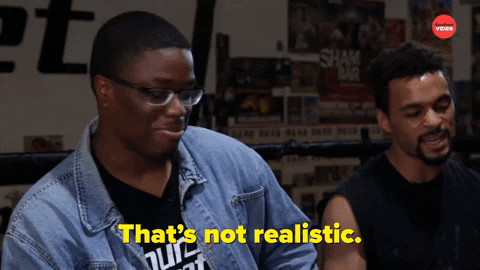 Giphy
GiphyUnmanaged expectations. If there is a main reason why the holiday season tends to be so stress-filled for so many people, I’d bet good money that this is the cause. And when you’re in a long-term relationship, expectations can manifest themselves in all sorts of cryptic and/or unexpected ways. You might have relatives who assume that you are going to be with them for Thanksgiving or Christmas when you have other plans in mind. You might be thinking that you are going to spend one amount for presents while your man is thinking something totally different. When it comes to scheduling, your signals may be crossed.
And you know what? To all of these scenarios, this is where clear and consistent communication come in. Don’t assume anything. Don’t dictate anything either. From now until New Year’s, mutually decide to check in once a week, just to make sure that you are both on the same page as it relates to the holidays and what you both are thinking will come along with it. The less blindsided you both feel, the less stressed out you will be. Trust me on this.
Set (and Keep) a Budget
 Giphy
GiphyOkay, so I read that last year, 36 percent of Americans incurred some type of holiday-related debt. Hmph. Last year, there was still some sense of normalcy in this country, chile, so I can only imagine what finances are gonna look like over the next several weeks. That said, since I don’t know a lot of people who don’t find being broke stressful, make sure that you and your bae set a budget and then stick to it this year — no ifs, ands or buts.
Because really, y’all — it doesn’t make sense to deplete savings and/or max out credit cards for a few days of giggles only to be damn near losing your mind because you don’t know how to make ends meet come Dr. Martin Luther King, Jr. Day.
And by the way, this tip doesn’t just speak to things like food and gifts; I also mean travel. If it doesn’t make a ton of sense (or cents) to be all over the place this year — DON’T BE.
Keep Matthew 5:37 at the Forefront
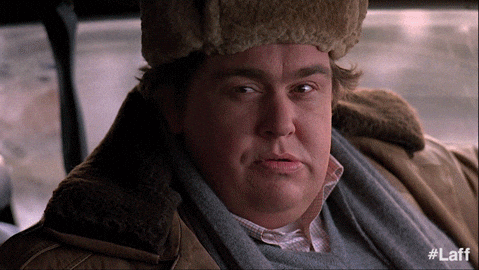 Giphy
GiphyIf off the top of your head, you don’t know what Matthew 5:37 says, no worries, here ya go: “But let your ‘Yes’ be ‘Yes,’ and your ‘No,’ ‘No.’ For whatever is more than these is from the evil one.” That verse right there? Oh, it’s a boundaries lifesaver! I say that because do you see “maybe” or “I’ll think about it” in there? Nope. LOL. It says that you should tell people “yes” or “no” and leave it at that — and that complements Anne Lamott’s quote, “’No’ is a complete sentence” impeccably well. Yeah, you’ve got to remember that anything beyond a yes or no to a request is privileged information; you don’t owe anyone details or an explanation.
Besides, if you are really honest with yourself, when someone asks you something and you give a “Umm, let me think about it” kind of reply, more times than not, you already know what your answer is going to be — so why not let you both off of the hook? Give your response. Commit to that. And let everyone (including yourself) get on with their lives and schedules.
I promise you that when it comes to those holiday parties, you are pissing more folks off by not RSVP’ing or doing so and not showing up than just saying, “Thank you but not this year” off the rip.
Remember That Your Personal Space Is Privilege Not a Right
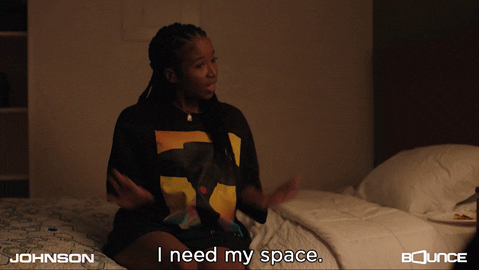 Giphy
GiphyA friend of mine recently bought a new house and invited me over to come see it. He’s a single man with no children, so as I was taking in all of the space that he had, especially as I walked through his finished basement, I joked about relatives coming to live with him. “Hell no” and “absolutely not” were pretty much his immediate responses as he went on to say that some folks even had the nerve to be offended when he told them that he had no intentions on taking DNA in.
Ain’t it wild how people think that your stuff is their right? And yes, that brings me to my next point. Your home is your sanctuary space. If you want to host folks this year — cool. If not, ALSO COOL. Please don’t let folks (family included) guilt you into how they want you to act or even into what they would do if the shoe was on the other foot. You are not them — and as one of my favorite quotes states, “If two people were exactly alike, one of them would be unnecessary.” (A man by the name Larry Dixon said that.)
Hell, my friends? They know that I am good for sending them random things that they need or even want all throughout the year. Coming over to hang out at my pace, though. Uh-uh. Chalk it up to being a card-carrying member of the ambivert club yet I like keeping my living space personal — and I sleep like a baby, each and every night, for feeling that way.
Always remember that your space, your time, your resources, your energy and shoot, yourself period (including your relationship), are all things that are your own. You get to choose how, when and why you want to share them. The holiday season is certainly no exception.
Cultivate Some “You Two Only” Traditions
 Giphy
GiphyIt’s not uncommon for some couples to hit me up after the holiday season to “detox.” Sometimes it’s due to the financial drama (and sometimes trauma) that they experienced. Sometimes it’s because they allowed their relatives (especially in-laws) to get more into their personal business than they should’ve. More than anything, though, it tends to be because they didn’t get enough quality time together and so ended up feeling “disconnected.”
Please don’t let that happen. Listen, I’m not even a holidays kind of woman and yet, I will absolutely sit myself down with some hot chocolate and chocolate chip cookies to enjoy a Hallmark holiday film or two. Aside from the fact that most of them are lighthearted and sweet, I also like that they usually focus on couples loving on each other amidst all of the holiday beauty and ambiance — which is something that all couples should set aside some time to do.
Maybe it’s a vacation. Maybe it’s a staycation. Or maybe it’s my personal favorite, A SEXCATION. Whether it’s for a few days, the weekend or even overnight — don’t you let the holidays go by without setting aside time for you and your man to celebrate one another. Don’t you dare (check out “Are You Ready To Have Some Very Merry 'Christmas Sex'?”).
GET. SOME. REST.
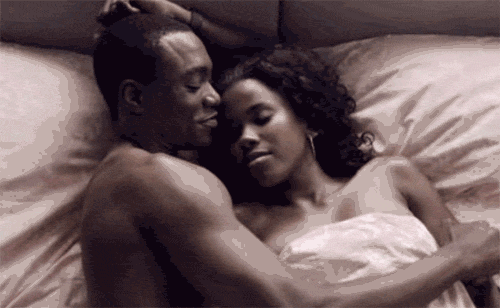 Giphy
GiphyI once read that 8 out of 10 people get stressed out over the holidays and 3 out of 10 lose sleep during to it — and when you’re stress-filled and sleep-deprived, that can absolutely lead to hypersensitivity, making mountains out of molehills and even not being in the mood for sex.
Your relationship can’t afford to go through any of this, so definitely make sure to prioritize rest. I don’t care how unrealistic it might seem during this time, sleep should never be seen as a luxury; it will always and forever be a great necessity.
That said, try to get no less than six hours of shut-eye in (check out “6 Fascinating Ways Sex And Sleep Definitely Go Hand In Hand”) and even ask your bae to take a nap with you sometimes (check out “Wanna Have Some Next-Level Sex? Take A Nap, Sis.”). Not only will sleep help to restore your mind, body and spirit but, when it’s with your partner, it’s an act of intimacy that can make you both feel super connected, even in the midst of what might feel like chaos.
___
Holiday season stress is real. Still, never give it the permission or power to throw your relationship off. Put you and your man first and let the holidays be what they are gonna be, chile.
Let’s make things inbox official! Sign up for the xoNecole newsletter for love, wellness, career, and exclusive content delivered straight to your inbox.
Featured image by Shutterstock
How To Avoid Being An Emotionally Impulsive Spender This Holiday Season
Geeze. Can you believe that we are just a few days out from another Christmas? Yeah, me neither. In fact, because I’m not a holidays person myself (check out “So, What If You Don't Observe Holidays?”), it wasn’t until one of my clients was venting about how stressed out she was due to all of the holiday season procrastinating that she had been doing that I realized just how fast December is actually flying by.
If, like her, you’re feeling frazzled because, although you told yourself last year that you weren’t going to wait until the last minute to “handle your business,” you ended up doing exactly that, fret not. I’ve got 10 tips that can keep you from making emotionally-triggered decisions as far as your financial expenses are concerned. Merry Christmas. #wink
1. Create a Budget. Stick to It.
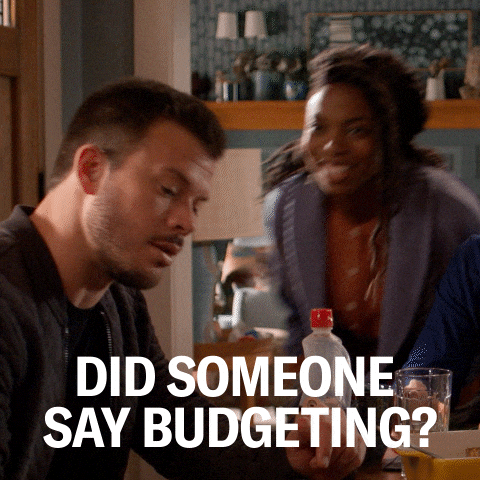 Giphy
GiphyBudgets, boy. I recently read that one of the reasons why they don’t work for a lot of people is because many folks don’t have a clue about how much money they spend on a monthly basis to begin with. SMDH. That said, at the end of the day, it’s important to remember that a budget is simply setting boundaries/limits on your spending — and being intentional about moving in this fashion is always a wise move; especially when it comes to this time of the year…especially being that it’s typical for half of all Americans to take on some type of holiday season debt with 17 percent needing six (or more) months to pay it off.
Know what can prevent this kind of financial chaos? A SPENDING BUDGET. Tips for how to create one of your own this year can be found here.
2. Never Shop When You’re Stressed or Pressed
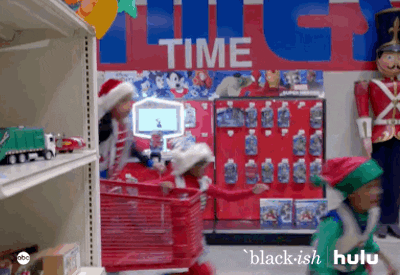 Giphy
GiphyYou know how they say that it’s not a good idea to go grocery shopping when you’re hungry? Although the holiday season can be a stressful time, avoid shopping for gifts (or décor or food for recipes) when you are feeling stressed out or pressed for time. More times than not, that cultivates anxiety which could cause you to either purchase things that you don’t really want or to spend money that you don’t really have (P.S. If you’re relying on credit cards, that qualifies as money that you don’t really have. Just sayin’).
3. Don’t Keep Up with the Joneses
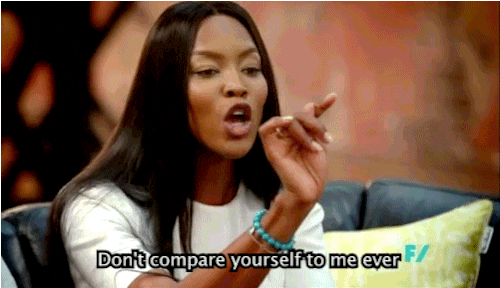 Giphy
GiphyKnow something else that can stress you out: trying to keep up with the Joneses. And y’all, now that we have social media, the reality is that envy is at an all-time high. That’s because it can be really easy to watch holiday engagements, holiday trips and folks bragging about the things that they’ve received in times past, only for you to find yourself wishing that you were them — or putting pressure on yourself and those in your world to keep up.
Listen, it is King Solomon who once said, “So are the ways of everyone who is greedy for gain; It takes away the life of its owners” (Proverbs 1:19 — NKJV) and “A sound heart is life to the body, but envy is rottenness to the bones” (Proverbs 14:30 — NKJV) and he’s considered to be the wisest man who ever lived (during his time — I Kings 4:30). Yeah, both of these verses are a spiritual reminder that whatever you are planning to do or give, do it out of the goodness of your heart — not so that you can low-key “outdo” the next guy.
4. No Need to “Tit-for-Tat”
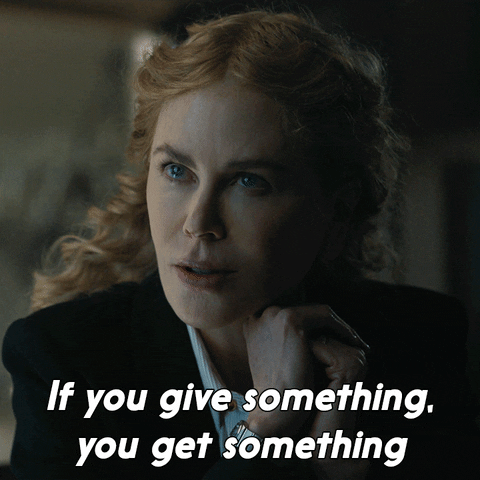 Giphy
GiphyThis one might be a bit controversial yet I’m totally okay with that. I don’t care what the occasion is, no one is OWED a present. A gift is a voluntary token of one’s appreciation or affection. That said, if you decide to give someone a present this year, don’t automatically expect something in return. If you get something, cool. If not, if you were giving for the right reasons, it really shouldn’t matter (RIGHT?). On the flip side, if someone decides to get you something and you don’t have something to offer in return, also cool.
Other than going to someone’s home for a holiday dinner or party, for anyone to feel like they should have something in hand because someone else does…that’s not giving, that’s competing — and that absolutely should not be the spirit that you are in (or around) during this time of year.
Again, a gift is not an obligatory thing. If you’ve always thought otherwise, it’s time to do some serious reprogramming.
5. Avoid the Pressure to Buy for Lots of Adults
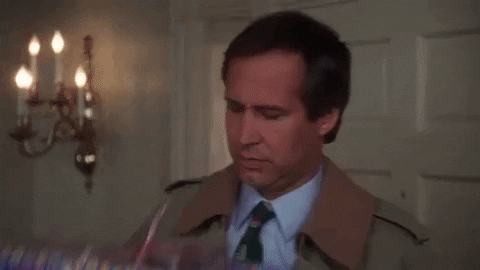 Giphy
GiphyLast month, Newsweek published an article that said it’s wise to not spend a ton of money purchasing gifts for adults. A financial expert in the piece said that it’s best to buy for kids because, more times than not, you’re going to get adults something that they already have a lot of, they don’t really need or they’re not going to use (beyond maybe regifting) anyway.
If you’re not feeling that insight, my take would be to exchange names and set a price cap for the grown folks. I say that because, I don’t think that people ever outgrow wanting something over Christmas. It’s just that the over-the-top energy should be reserved for the kiddies — and even then, the “4-gift rule” (want, need, read, experience) is probably your best bet for them…financially and otherwise.
6. Go for Thoughtful over Expensive
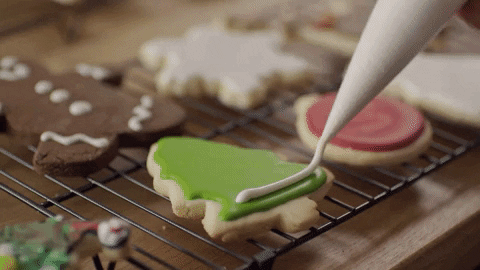 Giphy
GiphyIt’s kind of wild how much close-to-torture folks send themselves through to purchase gifts that, a good 6-8 months now, most folks aren’t even going to remember. That’s why it’s also a good idea to purpose in your mind to get something thoughtful over expensive.
Honestly, that’s a big part of the reason why Etsy continues to be a go-to for gifts (for every occasion) for me. It’s because you can oftentimes get things customized/personalized which ends up meaning so much more to people than something that you bought at a generic department store that might have a high price tag yet still lacks in sentimentality and deep meaning.
7. Use Coupons and Promo Codes
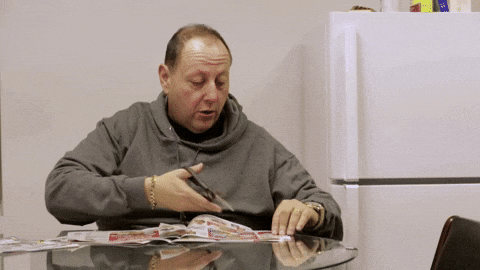 Giphy
GiphyCoupons (and promo codes) are a slippery slope in the sense that…they remind me of when I used to go overboard while thrift store shopping. I say that because, just because I might find several bomb dresses for under $20, what am I going to do with 50 of ‘em (over time)? It’s just as much of a waste of money as buying couture if neither option gets much use.
And that’s kind of the thing about coupons and promo codes. Some people end up overspending because they rationalize that so long as there are discounts attached, it’s all good. At the same time, this doesn’t mean that you should forego coupons and promo codes altogether. The key is to put together your shopping list (and budget) and then use discounts specifically for those items. If you do this, you could save well over $1,000 annually (at least, depending on what you decide to buy).
8. Avoid Add-Ons
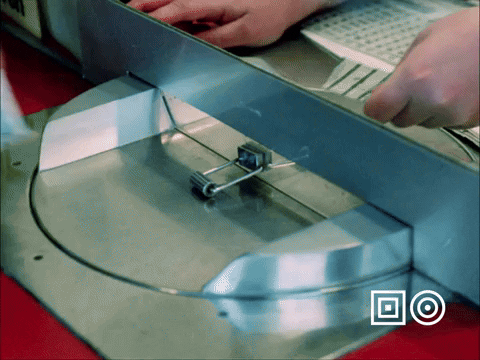 Giphy
GiphyYeah. Dodge add-on expenses. Add-ons like what? The first thing that comes to my mind is a warranty. What’s the chance that someone is actually going to need that? Another example is paying for things to be “professionally” gift wrapped. Chile, throw that stuff in a gift bag with some tissue paper and go on about your day. All good.
9. Rethink Gift Cards
 Giphy
GiphyIf there is any time of the year when there is a noticeable hike in gift card purchases, now would be it. And although they are a convenient approach to gift giving, at the same time, many come with hidden fees, the full amount oftentimes goes unused (which ends up being a waste of money) and they do come with expiration dates that are oftentimes forgotten.
So, if you’re someone who likes to wait until the last minute to do your holiday shopping, resist the urge to impulsively pick up a handful of gift cards. Unless it’s to a place that you know someone is going to use within the next few months, they could end up in somebody’s kitchen drawer for the next couple of years. And what a waste that would be.
10. They’ll Get It When They Do. And That’s Okay.
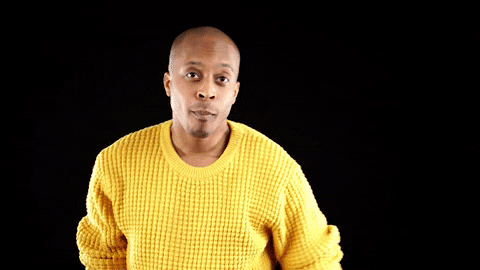
=
GiphyOne more. Although it is super thoughtful and proactive to get people their gifts in time for whatever occasion you purchased them for, if trying to reach that goal is going to require paying for rush shipping that is damn near as high as the price of gift or spending a lot of gas money that you don’t have at the moment to drive miles and miles away — take the pressure off to spend a ton of cash just to make sure that something arrives at December 25. Listen, through doing business with Etsy, I have learned that through this administration, there are all sorts of tariff issues going on and the USPS is slower than ever too, so paying more may not guarantee much.
The hack? Send a message that something special is coming…soon enough. The thought really is what counts (more times than not); plus, it builds anticipation of something good coming, even if it’s after all of the Christmas Day hoopla. And no one (with sense) is going to have a problem with that.
Now don’t you feel better? Happy Holiday Shopping, sis.
Let’s make things inbox official! Sign up for the xoNecole newsletter for love, wellness, career, and exclusive content delivered straight to your inbox.
Featured image by Shutterstock

